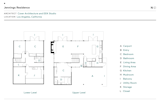Designed by Craig Ellwood, Case Study House #16 was the first of three houses in Arts & Architecture magazine’s Case Study House program. Ellwood—who had been trained as an engineer—was a contractor with no formal architectural training and Case Study House #16 remains the only surviving, intact example of Ellwood’s designs for the program. His passion for industrial materials is evident in the use of of steel, glass and concrete.
Despite its numbering, Case Study #1 was not the first house to be completed as part of Arts & Architecture magazine’s Case Study House program. Designed by Julius Ralph Davidson, the 2,000 square foot house was completed in 1948. Situated on a gently sloping lot in the prestigious Toluca Lake neighborhood of Los Angeles, the house introduced architectural elements that came to characterize the program such as floor to ceiling glass, a flat roof and an open floor plan.
The Bass House, which is known as Case Study House #20B (there were two Case Study Houses numbered 20), was constructed in 1958 in Altadena, California. The home differs from the other Case Study Homes in that it was built primarily out of wood, instead of steel. Designed by the architectural firm of Buff, Straub, and Hensman who worked closely with the owners, renowned graphic illustrator Saul Bass and his wife biochemist Dr. Ruth Bass--the architects were interested in the possibilities of wood as it pertained to mass production in home construction.
Lesser known but equally stunning is Pierre Koenig’s Bailey House, Case Study House #21. A simple one-story box with a flat roof, built mostly of steel and glass, Koenig achieved his goal of designing a home which was both affordable and beautiful. The Bailey House currently houses Seomi International Gallery which offers visits by appointment.
From the 1940s through the late 1960s, Arts & Architecture was the unofficial headquarters of California’s nascent modernist movement. It spearheaded the Case Study House Program, which produced some of America’s greatest residences. VKG furniture was used for many of the houses, and appears in photos shot by Julius Shulman, as seen above.
“We designed this home so that we can be here forever,” says Steph. Accessibility features include a ramp leading to the front door and showers with small curbs. The materials selected for the deck and roof intentionally have 40-year lifespans, while gutter protectors eliminate the need for cleaning: “There will be a point where we don’t need to be on ladders cleaning out gutters,” adds Steph.
152 more saves



































